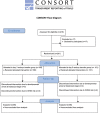Day 3 embryo transfer versus day 5 blastocyst transfers: A prospective randomized controlled trial
- PMID: 28913142
- PMCID: PMC5558418
- DOI: 10.4274/tjod.99076
Day 3 embryo transfer versus day 5 blastocyst transfers: A prospective randomized controlled trial
Abstract
Objective: This study aimed to show whether transferring day 5 embryos resulted in higher implantation and pregnancy rates than transferring day 3 embryos in Turkish women undergoing an intracytoplasmic sperm injection (ICSI) cycle.
Materials and methods: A total of 190 women who had ICSI after retrieval of more than four oocytes on the day of fertilization check were randomly assigned to undergo embryo transfer either on day 3 or day 5.
Results: Day 3 and day 5 transfers were statistically similar with respect to the age of woman (p=0.107), duration of infertility (p=0.528), cause of infertility (p=0.850), number of collected oocytes (p=0.119), number of metaphase II oocytes (p=0.178), number of fertilized oocytes (p=0.092), and number of transferred embryos (p=0.556). The number of grade 1 embryos was significantly higher in day 5 transfers than in day 3 transfers (p=0.001). Day 3 and day 5 embryo transfers had statistically similar implantation, clinical pregnancy, twinning, and live birth rates (p=0.779, p=0.771, p=0.183, and p=0.649, respectively). The live birth rates in singleton pregnancies conceived after day 3 and day 5 embryo transfers were statistically similar (p=0.594).
Conclusion: The efficacy of blastocyst transfer is not inferior to that of embryo transfer on cleavage stage. Performing blastocyst transfer may have benefits because it is associated with acceptable pregnancy rates and morphologic assessment on day 3 has limited predictive value for subsequent embryonic development.
Keywords: Blastocyst; embryo transfer; in vitro fertilization; intracytoplasmic sperm injection.
Conflict of interest statement
Conflict of Interest: No conflict of interest was declared by the authors.
Figures
References
-
- Maheshwari A, McLernon D, Bhattacharya S. Cumulative live birth rate: time for a consensus? Hum Reprod. 2015;30:2703–7. - PubMed
-
- Moragianni VA, Penzias AS. Cumulative live-birth rates after assisted reproductive technology. Curr Opin Obstet Gynecol. 2010;22:189–92. - PubMed
-
- Malizia BA, Hacker MR, Penzias AS. Cumulative live-birth rates after in vitro fertilization. N Engl J Med. 2009;360:236–43. - PubMed
-
- Guzoglu N, Kanmaz HG, Dilli D, Uras N, Erdeve O, Dilmen U. The impact of the new Turkish regulation, imposing single embryo transfer after assisted reproduction technology, on neonatal intensive care unit utilization: a single center experience. Hum Reprod. 2012;27:2384–8. - PubMed
-
- Sigalos G, Triantafyllidou O, Vlahos NF. Novel embryo selection techniques to increase embryo implantation in IVF attempts. Arch Gynecol Obstet. 2016;294:1117–24. - PubMed
LinkOut - more resources
Full Text Sources
Other Literature Sources

